  
Exhibition: "Longing for Paradise":a solo exhibition at NL=US Art The exhibition: “Longing for Paradise” shows video projections in which animals play the leading part. The videos are filmed from 1 point of view. The videos use “congealed time”; ephemeral moments are stretched into an everlasting “state of being”. Due to the often-dark background of the video projections, these animals melt into the new environment. They are often integrated into the architecture. The animals in this exhibition have become metaphors and symbols.
SHOW VIDEO
VOLKSKRANT NRC PRESS RELEASE

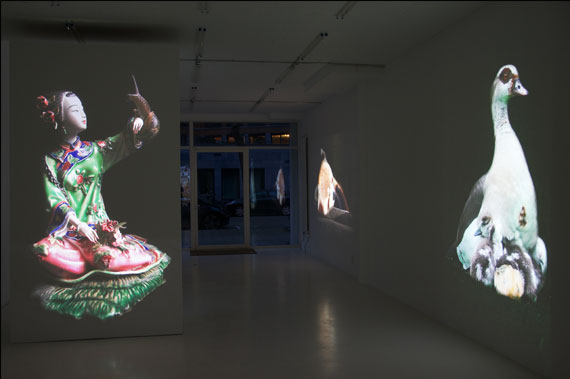

“Longing for Paradise”
A solo exhibition by Marjan Laaper at NL=US art Rotterdam, The Netherlands
Marjan Laaper specializes in large-scale video projections, installations, and art commissions in public space.
Simple everyday phenomena are presented in a poetic, sometimes philosophical framework. Often there is a tension between conflicting subjects and symbols, such as beauty and danger, the immaterial and the transient, trust, and alarm.
The life cycles of humans and nature play an important role in her video work and installations. The work does not provide clear answers but shows recognizable elements that raise questions. Her videos symbolically refer to universal aspects of existence.
The longing for a perfect world full of beautiful and good things remains timeless. Paradise would have been such a world, and plants and animals were considered a legacy of this lost world. The title of the exhibition: “Longing for Paradise” refers to this longing. A longing for a connection with nature, animals, “the self” and the imperishable. In her work, Marjan Laaper plays with this fascination for nature, but the nature in her video projections has been manipulated. The animals have been isolated from their original environment, slowed down, simplified, and seem to have become ornaments in a new setting. They look at the viewer or explore the environment. Other animals seem to be in a universe of their own.
Marjan Laaper is fascinated by old stories, parables, and spiritual texts in which the animal is used as a symbol for the supernatural. Animals are also often used as a metaphor for human actions, virtues, or behavior.
In Eastern religions nature is seen as a source of philosophical wisdom. Each part of nature is reminiscent of a quality that we fear or admire and should cherish in ourselves. The titles in her work refer to these stories. She takes advantage of our tendency to attribute human qualities to animals. The animal then functions as a mirror for human qualities attributed to the work by the spectator. This fact, which is called Anthropomorphism, plays an important role in her work.
The Messenger, (Wreathed hornbill)
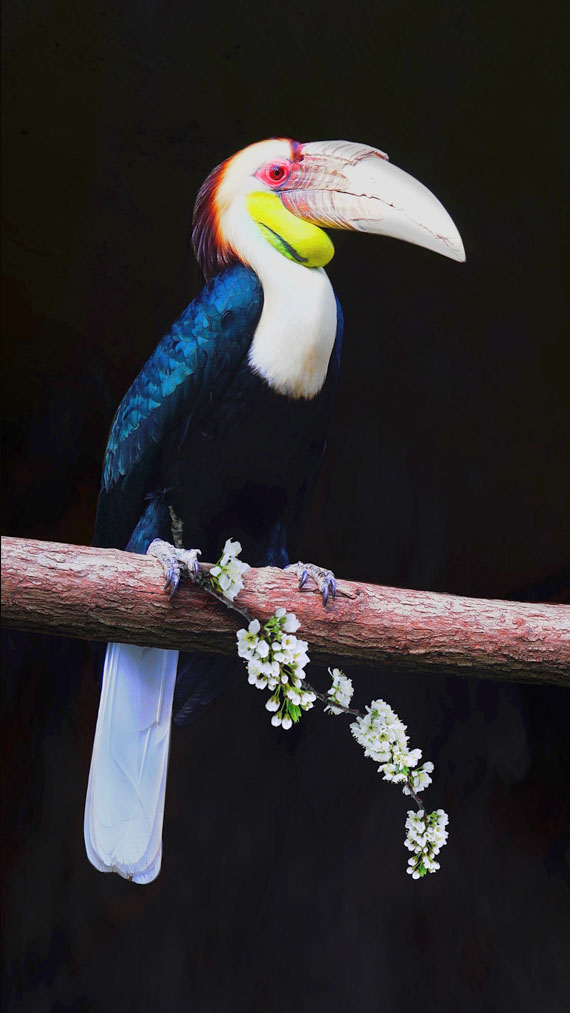
In the work "The Messenger", a Wreathed hornbill can be seen sitting on a branch. Due to the dark background, the animal merges with the space in which it is projected. The bird has become an ornament in the new environment. He looks at the viewer. He holds a blossom branch in his paw. The flowers slowly open and then close again as a rhythmic breathing movement. Blossom is often seen as the symbol of fleeting beauty and a life beyond our control, but also represents a new beginning. From time to time there is a smoke mist that moves upwards towards the bird. This haze sometimes seems poetic until the amount becomes so much that the bird seems to disappear in it. Is this bird the herald of imminent danger or is he the hopeful messenger of prosperity? In the work “the Messenger” it is up to the viewer to give the answer.
Encounter, (Bengal Eagle Owl)
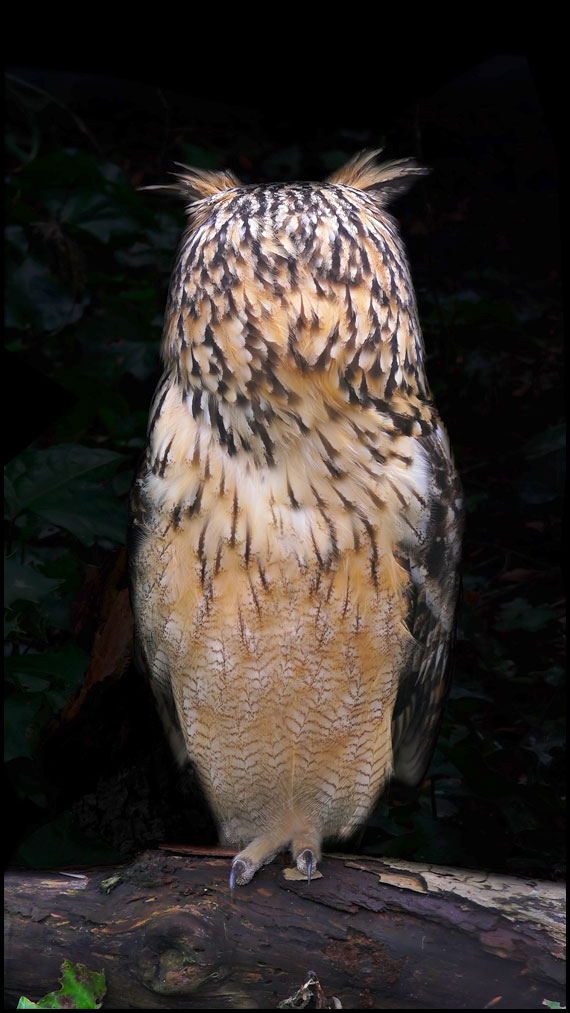
The work “Encounter” shows a larger than life projection of a Bengal Eagle Owl. The bird is sitting on a tree trunk with its back turned towards the viewer. The feathers on its back are a camouflaged version of a face. In time, the owl turns to the viewer and observes the space with its bright orange eyes. It is a game of watching and being watched. The owl seems like a guard who explores its new environment and confronts the viewer with its penetrating gaze. The title; "Encounter" refers to an encounter with another being. This encounter transcends the purely intellectual and is above all a poetic encounter.

“Refuge” (Egyptian goose with chicks),
In the work “Refuge” an adult Egyptian goose can be seen with a group of young chicks who together seek safety and warmth near the adult bird. Close to the goose they seek shelter from the outside world. This vigilant bird keeps a close eye on the environment and looks intensely at the viewer. The Egyptian goose did not originally occur in Europe but was introduced in the 18th century as an ornamental bird, after which escaped birds soon started breeding in the wild. In the video, not only goose chicks seek shelter at the bird, a one-day old chick has also found refuge at her side.
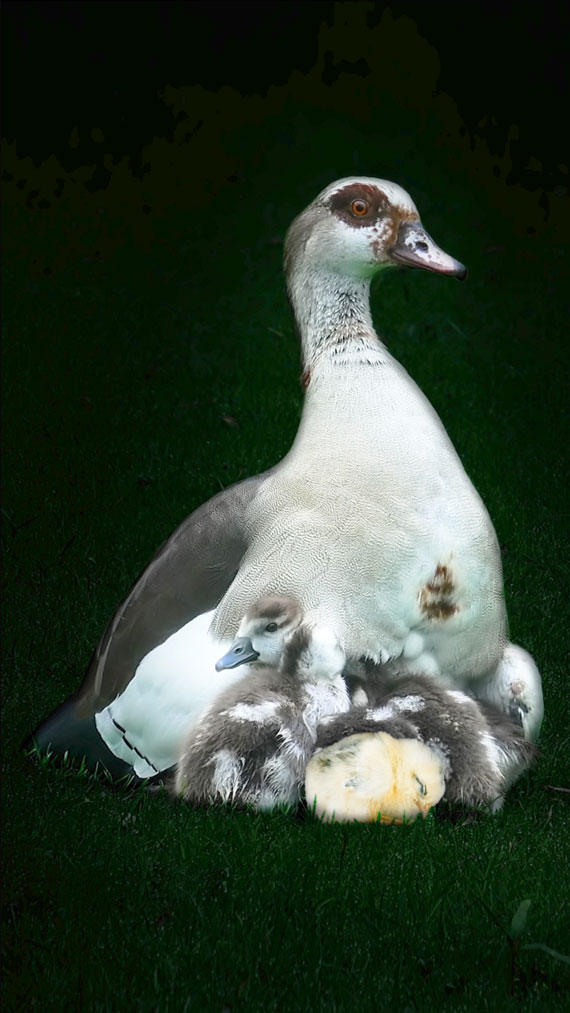
A sense of Wonder
In the work: “A sense of wonder” a Chinese porcelain statue of a female figure is filmed looking at an insect on her hand. A snail has crawled onto her hand and is exploring its surrounding. There is a strong contrast between the living insect and the static sculpture.Although the theme of wonder can be recognized in both the sculpture as in the exploring snail, the image also evokes alienation.The female sculpture and the snail, seem to form their own small universe that must be explored and discovered. The female figure is dressed in an early Qing (1644) costume.However, the statue is from the late 20th century and glorifies both the past and the bond that man and nature can have.
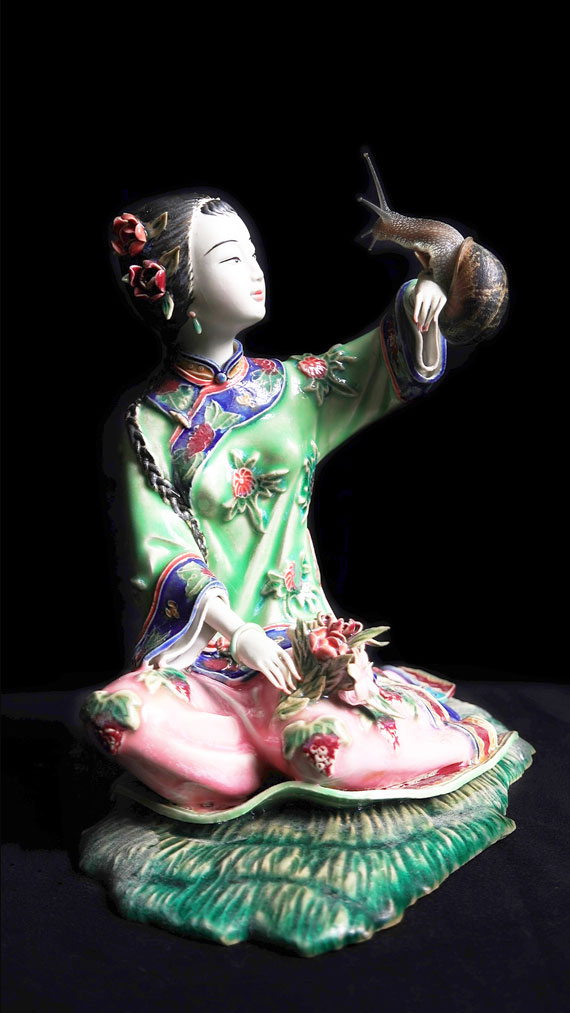
Breathe, (Red Panda)
In the work: “Breathe” a red panda can be seen resting its head on a wooden trunk.The background is dark.From the right side of the image, a strong and focused beam of light shines on the face and back of the panda.The animal is sleeping in the center of the image.The viewer witnesses this vulnerable moment in which the animal
finds itself. The panda was filmed from 1 point of view and is at eye level. Everything serves to show the animal as good as possible. We can hear the animal breathe softly, sometimes slowly, sometimes accelerating. The rhythm of his breathing is irregular. Sometimes the sound is silenced and the animal lies motionless in the center of the image. The irregular breathing of this vulnerable animal evokes an oppressive image. The image also evokes tenderness and wonder. The image makes us aware of the rhythm and the vulnerability of existence.

|